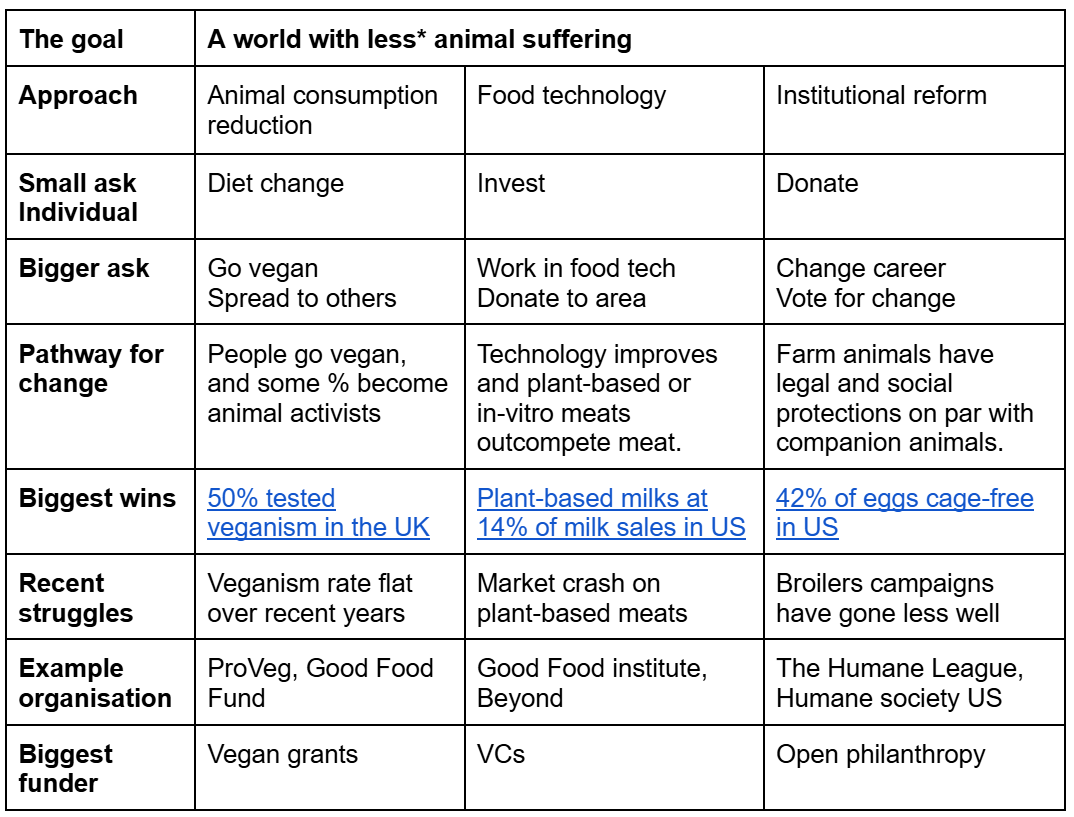Three theories of change for the farmed animal movement.
I wanted to make a quick theory of change table for different approaches that the farmed animal movement is currently using. Definitely imperfect and does not capture everything, but it has been a useful framing when I am talking to others about the different ways to get to worlds with less animal suffering.
*Some might say no animal suffering, but there will likely be some even after these pathways happen for quite a while, even from just a pet animal getting a cavity or a wild animal falling out of a tree.



Great to make a simple overview like that.
Wonder if you would count institutional diet change (e.g greener by default) in the first or third column. Doesn't entirely seem to belong in the first because go vegan is not the ask there (reduction is).
Thanks for the post, Joey!
I think decreasing the consumption of animal-based foods increases animal suffering due to increasing the suffering of wild animals much more than it decreases the suffering of farmed animals. I estimate School Plates in 2023, and Veganuary in 2024 harmed soil nematodes, mites, and springtails 5.75 k and 3.85 k times as much as they benefited farmed animals (https://forum.effectivealtruism.org/posts/Rjutj7Jd2v2KHvDyA/cost-effectiveness-accounting-for-soil-nematodes-mites-and). This is because I calculate decreasing the consumption of animal-based foods increases negative wild-animal-years way more than it decreases negative farm-animal years. For example, I estimate 0.1 kg less of chicken meat causes 2.87 animal-days less in directly affected animals (https://docs.google.com/spreadsheets/d/1NseiG9vppPxtrESyPfAyNHG5cyPCx8HFNrAqoYHtbOs/edit?gid=1129911864#gid=1129911864&range=B4), but that 0.1 kg less of chicken breast results in 4.65 M animal-years more in soil nematodes, mites, and springtails for feed crops replacing temperate grasslands, savannas, and shrublands (https://docs.google.com/spreadsheets/d/1NseiG9vppPxtrESyPfAyNHG5cyPCx8HFNrAqoYHtbOs/edit?gid=1129911864#gid=1129911864&range=P4), which is 1.62 M times as many animal-years.
The survey showing 50 % of people in the United Kingdom (UK) were vegan cannot be representative. The share of vegans has been 2 % to 3 % according to YouGov's surveys from 2019 to 2025 (https://ourworldindata.org/grapher/dietary-choices-uk?time=earliest).
I would say the share of veganism has been flat for longer than "recent years". In the United States (US), the fraction of people identifying as vegan went from 2 % in 2012 to 1 % in 2023, and the fraction of people identifying as vegetarian went from 6 % in 1999 to 4 % in 2023 (https://news.gallup.com/poll/510038/identify-vegetarian-vegan.aspx).